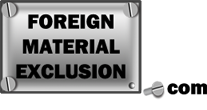 The costs of an FME program are seemingly one of the biggest hurdles to implementation. For some, it is tough to justify spending money on equipment and supplies in an effort to prevent something that is merely the possibility of higher costs. Many think that they won’t experience the expenses outlined below, but it’s a lot like health insurance: you keep paying for something that could happen and get no upfront benefit from it but when you do get sick or hurt you end up saving a lot of cash. Ask anyone who has gotten sick or injured without health insurance and you’ll know how it feels for a company without an FME program.
The costs of an FME program are seemingly one of the biggest hurdles to implementation. For some, it is tough to justify spending money on equipment and supplies in an effort to prevent something that is merely the possibility of higher costs. Many think that they won’t experience the expenses outlined below, but it’s a lot like health insurance: you keep paying for something that could happen and get no upfront benefit from it but when you do get sick or hurt you end up saving a lot of cash. Ask anyone who has gotten sick or injured without health insurance and you’ll know how it feels for a company without an FME program.
In FME you are paying to prevent future expenses but you are also getting great value as you pay. The reality is that most of the parts which are specially manufactured for foreign material exclusion are comparably priced to those items that are not fit for use in FME. For example: tinted plastic solutions are similar in cost to clear plastics. A lot of the items that are tailored for FME are also very long lasting, so the upfront cost is small and the return on the investment lasts a long time.
Expenses that FME programs will help to prevent:
Worker Injury
Worker injuries are not always the most expensive, but they are the most important reason to implement FME procedures.
Damaged Equipment
Damaged equipment is costly to repair. Preventing FOD from entering engines and foreign debris from entering machinery will save significant money.
Outages and Downtime
The costs of damaged equipment are not limited to the equipment itself. Lost production time to fix equipment and retrieve lost items is one of the most costly aspects of sub-par foreign material exclusion controls.


 Use our lanyard selection form and we'll help you get the right lanyards for the job.
Use our lanyard selection form and we'll help you get the right lanyards for the job.